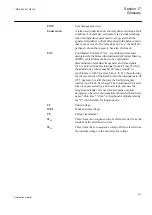
in the non-saturated region of operation. Class TPZ according to IEC is a non
remanence type CT.
Different standards and classes specify the saturation e.m.f. in different ways but it is
possible to approximately compare values from different classes. The rated equivalent
limiting secondary e.m.f. E
al
according to the IEC 61869–2 standard is used to specify
the CT requirements for the IED. The requirements are also specified according to
other standards.
16.1.2
Conditions
The requirements are a result of investigations performed in our network simulator.
The current transformer models are representative for current transformers of high
remanence and low remanence type. The results may not always be valid for non
remanence type CTs (TPZ).
The performances of the protection functions have been checked in the range from
symmetrical to fully asymmetrical fault currents. Primary time constants of at least
120 ms have been considered at the tests. The current requirements below are thus
applicable both for symmetrical and asymmetrical fault currents.
Depending on the protection function phase-to-earth, phase-to-phase and three-phase
faults have been tested for different relevant fault positions for example, close in
forward and reverse faults, zone 1 reach faults, internal and external faults. The
dependability and security of the protection was verified by checking for example,
time delays, unwanted operations, directionality, overreach and stability.
The remanence in the current transformer core can cause unwanted operations or
minor additional time delays for some protection functions. As unwanted operations
are not acceptable at all maximum remanence has been considered for fault cases
critical for the security, for example, faults in reverse direction and external faults.
Because of the almost negligible risk of additional time delays and the non-existent
risk of failure to operate the remanence have not been considered for the dependability
cases. The requirements below are therefore fully valid for all normal applications.
It is difficult to give general recommendations for additional margins for remanence
to avoid the minor risk of an additional time delay. They depend on the performance
and economy requirements. When current transformers of low remanence type (for
example, TPY, PR) are used, normally no additional margin is needed. For current
transformers of high remanence type (for example, P, PX, TPS, TPX) the small
probability of fully asymmetrical faults, together with high remanence in the same
direction as the flux generated by the fault, has to be kept in mind at the decision of an
additional margin. Fully asymmetrical fault current will be achieved when the fault
occurs at approximately zero voltage (0°). Investigations have shown that 95% of the
faults in the network will occur when the voltage is between 40° and 90°. In addition
fully asymmetrical fault current will not exist in all phases at the same time.
16.1.3
Fault current
Section 16
1MRK 505 291-UEN A
Requirements
316
Application manual
Summary of Contents for Relion REQ650
Page 1: ...Relion 650 series Breaker protection REQ650 Application manual ...
Page 2: ......
Page 20: ...14 ...
Page 26: ...20 ...
Page 48: ...42 ...
Page 82: ...76 ...
Page 90: ...84 ...
Page 160: ...154 ...
Page 178: ...172 ...
Page 264: ...258 ...
Page 288: ...282 ...
Page 302: ...296 ...
Page 330: ...324 ...
Page 338: ...332 ...
Page 339: ...333 ...



































